Please Take Note: This is a review of the game’s final prototype. The art, game bits, and the rules discussed are all subject to change. The game is being reviewed on the components and the rules provided with the understanding that “what you see is not what you might get” when the game is published. If you like what you read and want to learn more, we encourage you to visit the game’s web page or Kickstarter project page. Now that we have all that disclaimer junk out of the way, on with the review!
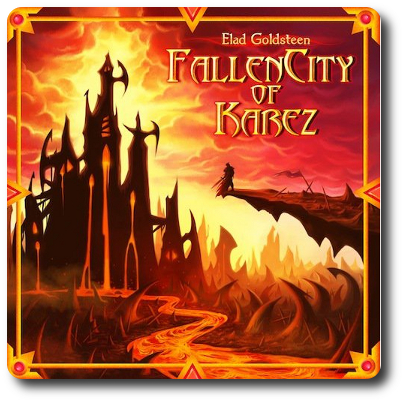
The Basics:
- For ages 12 and up
- For 2 to 5 players
- About 2 hours to complete
Geek Skills:
- Active Listening & Communication
- Counting & Math
- Logical & Critical Decision Making
- Reading
- Pattern/Color Matching
- Strategy & Tactics
- Risk vs. Reward
- Cooperative & Team Play
- Hand/Resource Management
- Worker Placement & Area Control
Learning Curve:
- Child – Hard
- Adult – Moderate
Theme & Narrative:
- The great city of Karez has fallen and it is up to the players to revive and rebuild it into a thriving city once more by any means possible
Endorsements:
- Gamer Geek approved!
- Parent Geek rejected!
- Child Geek rejected!
Overview
It once was the greatest city known to man. It was said that the walls of Karez were made of gold and all those who dwelled within them were blessed with prosperity and health. But those are just stories and the city is now nothing more than ruins. By royal decree, the leaders of the greatest Guilds have been summoned and given one command: rebuild Karez. Such an opportunity promises great wealth and personal gain of power, but it’s a balancing act and a deceitful one at that. Outwardly, the Guilds must appear to be working for the greater good of the Kingdom and their King, but secretly they work to further their own goals. Only by working together can the Guilds rebuild the fallen city of Karez, but they must fight each other to rule it.
Fallen City of Karez, by Golden Egg Games, is comprised of 1 game board, 5 Guild cards, 12 Hero cards, 51 Monster cards, 53 Item and Instant cards, 15 Building tiles, 14 Adventure cards, 23 Quest cards, 26 six-sided dice (12 red, 5 white, 4 green, and 5 treasure dice), 23 wooden Meeples (15 white and 8 black), 30 wooden cubes (red, blue, and gold), 7 Gem tokens, 35 Guild tokens (7 per Guild), 20 Level-Up tokens (10 Attack and 10 Defense), 5 Private Dungeon tiles, 6 Rest tokens, and 3 Monitoring markers. Sound like a lot? It is. We will not comment on the quality of the game we were passed as it is a prototype and the game art, as well as production value, are not finalized. We can, however, share with an examples of what the final artwork will look like. Feast your eyes on this!
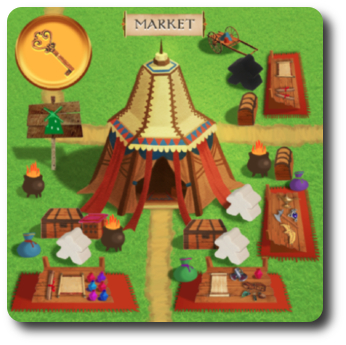
The proposed final artwork will look absolutely beautiful!
Among the Ruins
To set up the game, first place the game board in the middle of the playing area and within easy reach of all the players.
Second, separate the Monster cards into 5 different decks (Traps, Humanoids, Undead, Beasts, and Ancient) and shuffle. Place the decks face-down to the right of the game board in two rows. Hero cards should also be shuffled and placed with the Monster cards.
Third, have each player select a Guild card. This can be done randomly (the fast way) or each player can look them over the decide who gets what. Note that each Guild has a specific advantage, but no one Guild is more powerful than the other. However, each Guild also has their own goal, referred to as an “Ambition”, that might appeal to some players and not others. For your first game play, we suggest you randomly select the Guild cards. Once the players have selected their Guild card, each player will then collect the Guild tokens (7 in total), Private Dungeon token, any starting Building tiles, Gold cubes, Monster cards, Hero cards, and Quest cards as determined by their Guild card.
Fourth, each player now places their starting Building tiles adjacent to the game board along with one of their Guild tokens to signify they own the building (important when it comes to paying for the services each building might provide). They also now place one of their Guild tokens on the turn order track on the game board. The initial turn order is determine by the Guild the player selects.
Fifth, separate the Adventure cards into three different threat levels, shuffling each deck thoroughly. Place these three decks in their designated areas, face-down. Take the top card from the level 2 threat Adventure deck and place it at the bottom of the level 1 threat Adventure deck.
Last, place the starting workforce, represented by white and black Meeples, into the center of the game board. The number of starting Meeples is dependent on the number of players.
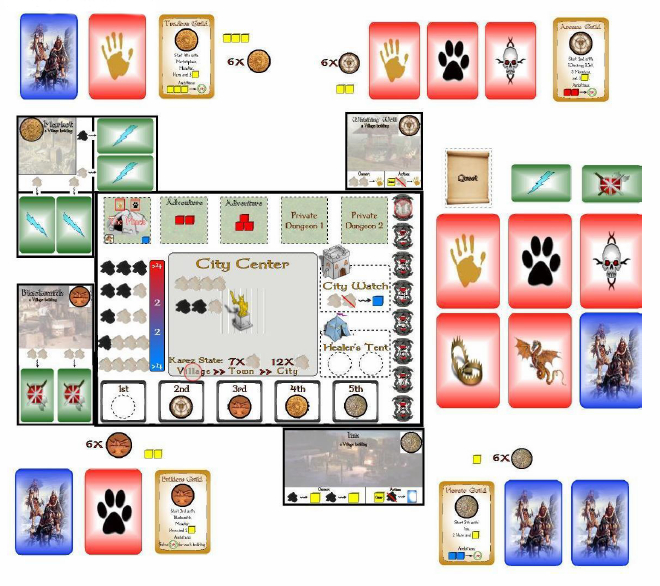
Example of a 4-player game set up with prototype game components
You are now done setting up the game! Starting with the player in the first position on the turn order track on the game board, begin your conquest of reconstruction and power mongering.
Rebuilding a Legend
Note: There is a lot to The Fallen City of Karez. To keep this review to a reasonable length, we will summarize the game play here and kindly suggest you refer to the game rules for additional details and specifics.
The game is played in 10 turns with each turn consisting of 5 phases. Players will complete each phase in turn order sequence. These phases and their summarized actions are as follows:
1. Action Phase
This phase has all the players focus their attention on assigning what actions they want to complete in the current turn. Players will play in turn order sequence, assigning one action per sequence, and repeating the process until all players have either passed or there are no further actions to assign. The available actions are as follows:
- Construct a Building: A player can select an available Building tile and build it (play it to the game playing area) by paying for its construction. The cost of construction is dependent on the current size of Karez. If it is small and still a village, a player only pays 1 Gold, if it is a Town the player pays 2 Gold, and if it is a City the player pays 3 Gold. Once paid for and played to the table, the owner places their Guild token on it signifying the owner of the newest building in the growing population of Karez.
- Send Workers: A player can collect 2 white Meeples (citizens of Karez) or 1 black Meeple (a visiting adventurer) and place them on any currently available job or action space. Depending on the Building tile, there will be freely available spaces that anyone can take and reserved spaces that only the owner of the building may use. A player must have an available Guild token to use another player’s building. If they do not, they cannot place any workers. Buildings the player owns, however, are always available to them and never require a Guild token. Additionally, players can assign adventurers to go explore their private dungeons, task citizens to man the city watch towers, or care for wounded Heroes by healing them.
- Buy an Item or Instant: A player can use this phase to purchase Item and Instant cards for their Heroes to use while exploring dangerous dungeons. These cards come from building locations.
- Send Heroes Forth: A player with Heroes who they feel are well enough equipped, can send them forth to explore and attempt to successfully complete an Adventure or destroy another Guild’s private dungeon. A Guild token is placed on either (depending on where the player wants to send the Heroes). Again, if there are no Guild tokens available, this action cannot be taken.
- Open a Private Dungeon: A player may open their doors to foolish adventurers who want to explore the depths of their tailor-made and highly lethal dungeon. The Private Dungeon card is placed on an available space on the game board which immediately becomes available to all other players.
2. Activity Phase
This phase has all the players activate any building action they selected during the first phase. In turn order sequence, each player will now activate one of the buildings and pay whatever is needed in order to complete it. Used Meeples are either returned to the center of the game board or temporarily set aside with any currently unused Meeples if they were sacrificed. Some of the building actions include sacrificing a Meeple to create an undead monster for later use in a Private Dungeon, generating goods to purchase, building traps, and attracting adventurers.
3. Adventure Phase
This phase determines the outcome of explored Adventures and Private Dungeons. This is perhaps the longest of all the phases and the most intense. The player will need to make several rolls of the die, assign hits, manage damage, and risk it all to gain big rewards. The steps are summarized here and are completed per player, per turn order.
- Explore an Adventure/Private Dungeon: The player places their Hero cards and any Items or Instants they want to equip. This is a one time set up and cannot be changed until the end of the phase.
- Encounter Threats: The player now reveals one Monster card based on the first card symbol. If attacking a Private Dungeon, the owner of that Dungeon gets to build their own encounter deck from the Monster cards they have collected.
- Fight or Flee!: The player completes combat by rolling dice, assigning hits, using equipment, and either taking out the encounter or losing Heroes. Probably both. Each Encounter has specific die values that must be rolled in order to do damage, as do the Heroes. This makes combat a very hands on experience and the player will need to do all they can to prolong the life and effectiveness of their Heroes. Combat will continue until all the Heroes have perished, runaway, or the last encounter has been successfully conquered. See the game rules for a complete break down of combat.
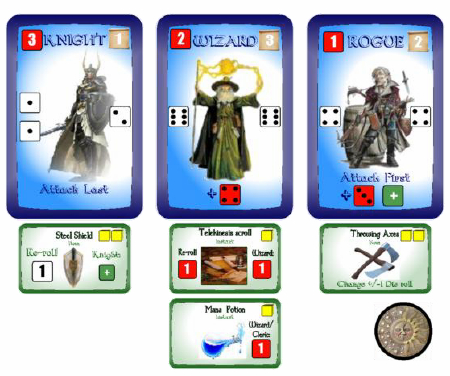
Example of a player’s Hero party, equipped and ready for adventure!
4. State of Karez Phase
This phase is heavily influenced by what the players have accomplished so far. The first adjustment is to the Threat-Valor monitor that determines the number of citizens and adventurers to add or subtracts from the current available number of Meeples. A higher threat level (more danger) attracts adventurers, but keeps the common citizen far away. On the other end of the spectrum is valor, which will attract citizens who are looking for a better life, but the lack of danger and opportunity for riches will keep the adventurers away. A healthy mix for Karez is in the middle and only possible if all the players help with the balance. But that’s not necessarily what every player wants.
The second adjustment is to the State of Karez monitor which will determine if Karez grows enough to move to the next highest level in its population evolution. This will determine when the small village of Karez grows to a town and eventually a bustling city. When Karez grows, new buildings and opportunities become available, but Karez can also shrink which will reduce available buildings and opportunities for wealth and power.
5. Turn End and Replenishing
This is the final phase and it resets the game board for the next round. New Adventures could be made available, rest and wound tokens are removed from Heroes, a new turn order is set based on the number of Valor cubes the players have (the player with the most Valor goes first, followed by the second highest and so on), and the turn marker is adjusted.
A City, For Better or Worse
At the end of the final round, the game is over. If Karez has not been transformed from a small village to a mighty city, all the players have lost the game. They did not successfully complete the royal decree and will receive no boons from their king. If, however, Karez has been reborn and successfully reconstructed to a city, the King will be most pleased and will reward each Guild points. Points are distributed based on a Guilds wealth, property, valor, Heroes, and dungeons. Each guild might also have additional points that only they can earn and are based on the final state of Karez (noted on each Guild card).
The player with the most points has done the best job and the King awards them the title of Mayor of Karez, making them the true winner of the game.
To learn more about Fallen City of Karez, read the full rules, learn more about the game’s development progress, and view the proposed final artwork and design, see the game’s web page or Kickstarter project page.
Prediction
I have no doubt that this is a game that my 7-yer-old has the ability to play, but not the stamina. It will take a couple of hours to complete and has a bit too many phases where critical thinking is necessary. I think this game will burn him out, if nothing else, instead of being a game that is beyond his comprehension. I’m not even going to attempt this with my 5-year-old who I know will be interested in it because of the many bits it contains, but disappointed in its game length.
For the Parent Geek crowd, I might have a parent or two who could pull this game off, but the group as a whole is more casual gamer than gamer-gamer. Which is precisely why I think Fallen City of Karez is going to appeal most to my Gamer Geek group. In fact, I wouldn’t be surprised if they are the only group who really enjoy the game and fully explore its level of strategy and tactics.
I was pleasantly surprised when my 7-year-old offered to set up the game. I warned him it would take him awhile to complete, but if he followed the instructions he wouldn’t have a problem. I also told him I would be right there to help (as the little geeks often help me with game set up) if he should need it. He accepted these terms and immediately got to work. It took him about 15 minutes (much longer than it would normally) and we had several discussions on what the bits were and how they interacted. This served to be an excellent way to teach him about the game, too, and might be a method I use in the future.
Teaching Fallen City of Karez is best done by teaching each phase of a game round and introducing game bits when needed. There are a lot of game components which can be exceedingly overwhelming for anyone if they are asked to take it all in at once. By breaking it down into phases, the players are gradually introduced the bits they will be using and need to be concerned about. It also helps that the game’s natural flow leapfrogs on the player’s last action which makes it an easy game to demonstrate cause and effect.
After about 15 minutes of discussion, some examples, and a lot of questions, my little geek was ready to play the game. We opted to allow the players to select their Guilds and went from there. He was very optimistic about the game, but not this chances in finishing it. Before we began, I asked him his thoughts on the game so far.
“This is a big game, but it helps that I know what everything is and what it does. I’m looking forward to building my dungeon!” ~ Liam (age 7)
His level of excitement is clearly tempered with a healthy dose of apprehension. I have made it very clear that games are nothing to stress about (there’s enough sources of stress in the world already) and when we need a break, we’ll take one. But for now, he’s ready to go and so am I. Let’s see if we can rebuild the city or if it remains in ruins.
Final Word
As expected, Fallen City of Karez was too much for my 7-year-old. He still remembers his game plays with Belfort, which has somewhat emotionally scarred him. The time needed to play, the depth in which a player must dive to play the game competitively, and the many “little things” that must be on the player’s mind were overwhelming. To his credit, he played a good 30 minutes and was strongest on the Action and Adventure phases, demonstrating excellent foresight by selecting useful locations to use and the necessary tactics to hold his own in combat. In the end, he was crushed by the weight of the game, not his inability to play it. He stood up and said, “I’m done, but I leave feeling good about it”, and walked out. I had the urge to 80’s slow clap as he left the room, broken but victorious.
Parent Geeks lasted longer but also succumbed to the demand of the game. A casual game this is not! The more “gamer geeky” of Parent Geeks were able to hold out the longest but eventually threw their hands in the air in defeat. All the Parent Geeks did fairly well and gradually became much faster in their decision making during the round phases. In the end, however, the game was just too long, too intense, and too involved for them to ever feel comfortable playing it. Non-gamers burst into a pillar of flame when they approached the board, so we kept them at a healthy and safe distance at all times.
Gamer Geeks thrived in the Fallen City of Karez. This is truly a “gamer’s game” and the semi-cooperative element was a big hit. There were some game rules that seemed fiddly to the Gamer Geeks and a bit out-of-place with the rest of the game. Specifically, the combat seemed to drag on a bit as there is much die rolling and then assigning the values. This created much unwanted downtime, but it was only enough for the Gamer Geeks to remark on, not dwell on. And since combat was not needed each round (Gamer Geeks didn’t send their Heroes into the depths of a dungeon unprepared), the rounds went pretty quickly.
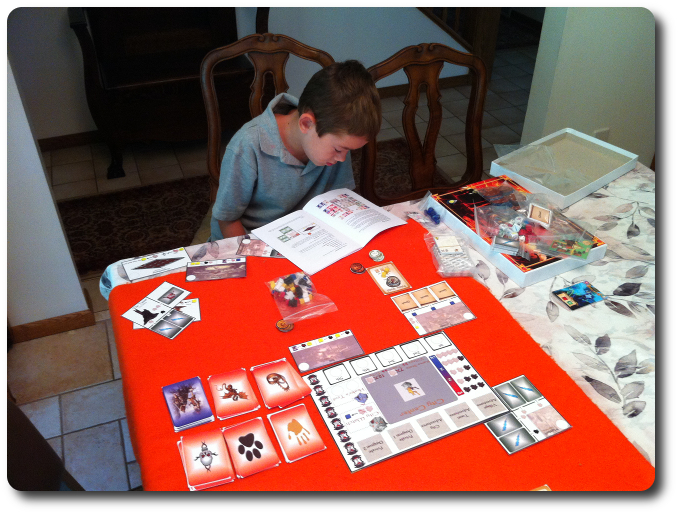
As my little geek sets up the game, we take the opportunity to learn what each game bit does and how the game is played
Gamer Geeks, this is a challenging, engaging, and deep semi-cooperative game that will test your ability to balance the game’s agenda with your own. Let me again state that this is a semi-cooperative, not a cooperative game. There can be only one winner, but the players must work together to get to the finish line. Each Guild, and by extension the players, will have their own agenda and ambitions that will award them more points at the end. These points might very well be the difference between victory and defeat when it comes to final point tallying, making them just as important as helping to rebuild the city. The moment the players start to mess with each other or stop focusing on the good of all, the game reacts. This was much-loved by the Gamer Geeks as the game clearly showed the consequences if the Guilds started to focus on their own personal gain versus helping each other. This served to be more than enough to keep the players highly entertained and squabbling among themselves. Of which, they loved every minute.
Parent Geeks, this is a game that will not be playable at the family game table until such time you have family members who can play the big games. There is a lot going on in Fallen City of Karez, which makes it a poor candidate for casual game play. The Parent Geeks we played it with wouldn’t recommend it with family or friends who were only looking for a light game or, at most, a game that would take an hour. Clearly not a game for casual play or for the non-gamers. There is just too much to the game, both in game play and the amount of energy and focus is requires from the players.
Child Geeks, here is a wonderful example of what you can expect to play in the future and should serve as an excellent reminder of why you are learning to play games in the first place. Everything you’ve been playing so far has elements that are used in future games. By learning to play more and more games, you are essentially making every game you will ever play in the future easier. Keep learning more games, steadily increasing in difficulty, and you will find games like Fallen City of Karez to be one day well within you reach of understanding and ability. Until then, this game should be set aside.
I found Fallen City of Karez to be wonderfully ambitious. It attempts to combine a number of tried and true Euro-style and traditional fantasy role-playing elements into a single game experience. I believe it has succeeded, but at a cost. When you throw more and more into a game, it increases the overall complexity and demand on the player. This reduces the appeal and accessibility for many, but also makes it more interesting to hardcore gamers.
In a single game, the players will be testing their ability to strategize, change their tactics from cooperative to agenda driven actions, balance personal gain with game advancement, resource management, worker placement, area control, constructing dungeons and buildings, and correctly outfitting an adventuring party to address risk and reward. Phew! That’s a lot and the game can feel exceedingly heavy at times. Heavy, but never unbearably so. Some phases are lighter than others based on the players’ current objectives. This makes each round different and the growth of the city and Guilds feels organic and natural. Perhaps the most interesting aspect of the game is watching how it responds to players and their current level of cooperation. This made for many heated table conversations and finger-pointing when the game was penalizing all the players because one or two specific players were being less than cooperative in their game play.
Fallen City of Karez is a big game where strategy and mental stamina is essential. Players have a lot to balance and a lot to think about. The clock is ticking and every move will need to bring Karez, as well as the players, closer to victory. The end result is a game that will tax the mind, stir the imagination, and leave those who play it breathless, sore, and wonderfully fulfilled. Do take a look at Fallen City of Karez if you are a Gamer Geek and enjoy thematic fantasy elements mixed in with heavy Euro-style game play.
This game was given to Father Geek as a review copy. Father Geek was not paid, bribed, wined, dined, or threatened in vain hopes of influencing this review. Such is the statuesque and legendary integrity of Father Geek.




Pingback: Viticulture Game Review (prepublished version) - Father Geek